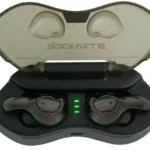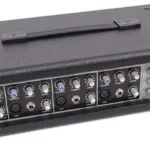



OWNER’S MANUAL
RPM45BT
4 CHANNEL WOOD CABINET POWERED
MIXER w/USB and BLUErOOTH
Thank you for purchasing this Rockville RPM45BT 4 Channel Powered Mixer with USB input and Bluetooth connectivity. Please read this owner’s manual carefully for proper use of your Rockville RPM45BT 4 channel mixer. Should you need technical assistance, please call our technical helpline at 1-646-758-0144, Monday through Friday, 9 am to 5 pm EST.
Includes
- Powered mixer w/Bluetooth
- Remote
- Power cable
- Owner’s manual
- Warranty card
IMPORTANT SAFETY INSTRUCTIONS

- To reduce the risk of electric shock, never open the unit. There are no user-serviceable parts, refer service to an authorized Rockville service center.
- Do not expose this unit to any kind of moisture.
- Please ensure that the unit is situated in a properly ventilated area.
- Make sure the unit is placed on a level and stable surface.
Functions

- Channel Bass control: ±15dB
- Channel Treble control: ±15dB
- Channel volume control: The volume level should be lower than the master level. This control acts as a preamp, if you are using a device that has a volume output control you will need to match levels by adjusting the level controls on each unit.
- Microphone/Low impedance XLR input: Connect balanced low impedance microphones with an input impedance of 1K PIN 1 = shield, PIN 2 = positive (hot), PIN 3 = negative (cold)
 WARNING: When using condenser microphones, make sure that Phantom power (48V) is switched on (see item 22).
WARNING: When using condenser microphones, make sure that Phantom power (48V) is switched on (see item 22).
- Line/High impedance 1/4– input: This input may be used as either high-impedance microphone input or for line-level devices such as a cassette player, CD player, video projector, or laptop. Will also allow connection from an electric guitar, bass or keyboard. It is a two-conductor input with an impedance of 10K ohms.
- Channel Echo: Controls the amount of echo added to the input signals.
- Balanced 1/4″ TRS Line Out: Sends the music signal to another amplifier, a powered subwoofer, powered speakers, monitors, or any other external device.
- Balanced 1/4″ TRS Line In Used to connect line-level sources: mixing consoles, samplers, CD players, cassette decks, DAT machines, and other audio interfaces.
- SD card slot: Inserting an SD card will set the RPM45BT to SD mode and it will automatically begin to play music.
- USB port: Inserting a USB flash drive will set the RPM45BT to USB mode and it will automatically begin to play music.
- Display screen
- IR remote receiver
- MP3 Player:
Play button: Quickly press during play to pause, press button again to resume play.
Mode: Use to switch between input modes (USB/SD, BT, and FM)
Repeat button: Quickly press during play to repeat the current song. Press again to repeat all songs. Press again to exit repeat mode.
Next button: Press to go to the next track.
Previous button: Press to go to the previous track. - Power indicator LED
- Digital delay effect (echo) controls Level: adjusts the mix level of the effect.
Time: controls the time interval of the delay.
Repeat: controls the rate of the delay - 3 Band equalizer: Adjusts frequencies ±15dB.
- RCA Line in: Used to connect line-level sources: DJ controller, mixer, samplers, CD players, cassette decks, DAT machines, MP3 players, etc. Mono audio sources can be connected using an RCA “Y” cable connector.
- RCA Record out: Sends signal to a recording device or any other line-level device.
- Line in volume control
- MP3 volume control (USB and SD input)
- Master volume control
- Phantom Power ON/OFF button (Red LED indicates power on): When activated, phantom power provides 48 volts DC to power condenser microphones.
Please note: Do not plug or unplug devices and mics while phantom power is on. It can cause severe damage to the mic. When phantom power is turned off, it is recommended you wait approximately 7 seconds so as to allow time for the voltage to completely die out.

- Variable voltage selector switch (110V/220V)
- Speaker outputs: 1/4″TS jacks accept 8-ohm speakers. WARNING: Do not operate below rated minimum impedance.
- User serviceable fuse
- IEC AC Power socket
- Power switch
Bluetooth Pairing and Operation
- Press the MODE button until you see BLUETOOTH on the display.
- Ensure that your device is in Bluetooth mode and discoverable.
- Find “RPM45BT” on your device’s list of available Bluetooth connections and select it.
- Once successfully paired, the RPM45BT’s LCD display will show “BLUETOOTH CONNECTED’.
- You can control playback from your device or you can use the MP3 controls.
Media Playback Sources
The RPM45BT will accept various media playback devices:
- To connect a turntable or CD player, use the CHANNEL 4 RCA inputs.
- To connect an MP3 Player or smartphone, use the’/:’ Line In jack or the RCA Line In inputs
USB/SD Operation
Inserting a USB flash drive or an SD card into the corresponding port/slot will set the RPM45BT to USB/SD mode and it will automatically begin to play music.
Music Playback (USB/SD and Bluetooth)
Play button: Press to play/pause the current track.
Next button: Quickly press to go to the next rack.
Previous button: Quickly press to go to the previous track.
Folder Selection (USB/SD only)
- Press and hold the Repeat button to enter the folder interface menu.
- Use the Previous/Next buttons to select the desired folder. The folder name will appear at the bottom right of the screen, the tracking number will appear at the top left. Track name and duration will appear on the right.
- Press the play/pause button to start or stop the current track.
Set-Up
In this setup, there is a powered subwoofer connected to the 1/4″ Line Out jack on the front of the unit (fig. a) and two 8-ohm speakers connected to the 1/3-8 Ohm Outputs on the back of the unit.

In this setup, there is a powered stage monitor connected to the IA” Line Out jack on the front of the unit (fig. a) and two 8-ohm speakers connected to the 1/4″8 Ohm Outputs on the back of the unit.

Once your speakers are hooked up, there are a variety of ways to use the RPM45BT’s many inputs and outputs.
Please note: The line-level consumer devices connected to channel 4 can also be connected to channels 1 – 3, but will require an RCA to 1/4″ cable.

Features/Specifications
- Rockville RPM45BT 1800W Powered 4 Channel Mixer/Amplifier with Bluetooth/EQ/Effects
- RMS Power Output: 225w x 2 @ 8 Ohm (parallel mono)
- Program Power Output: 450w x 2 @ 8 Ohm (parallel mono)
- Peak Power Output: 900w x 2 @ 8 Ohm (parallel mono)
- Built-in Bluetooth version 3.0 with 100-foot range and great sound quality
- Individual Volume, Reverb, Bass, and Treble controls
- Adjustable effects: Echo and delay
- USB/SD Input
- MP3 Volume control
- AUX volume control
- Master volume control
- 4 balanced XLR inputs
- 4 %C TRS inputs
- 1 RCA AUX input
- 1 1/4– master line input
- 1/4″ line output for adding a powered subwoofer or more amplifiers or powered speakers
- 1 RCA Rec output
- 1 1/4″ Effect loop input/output
- Amplified speaker outputs: 1/4″ TS (8-ohm)
- +48V phantom power
- Fan Vent Cooling System
- Dimensions: 18.9″ x 8.9″ x 6.3″
- Weight: 18Lbs.
Troubleshooting
| PROBLEM | SOLUTION |
| No power | 1.Make sure the unit is plugged in and the power switch is in the ON position. 2.Check that the power cable is plugged in tightly to the unit. 3.Check and replace the fuse if necessary. See fuse replacement diagram on the next page. |
| No sound | 1.Check that all appropriate cables are plugged incorrectly. 2.Check the Master Volume settings. 3.Check the individual level control of each channel as well as the MP3 volume control and Line level volume controls. 4.Be sure your microphone(s) is on. |
| Noise | 1.Turn down the channel levels one by one. If you don’t hear the sound then the problem is either with the channel or whatever device is plugged into it. 2.Unplug the device(s), to see if the sound disappears. 3.Make sure you are using the proper cables. For 3/4″ cables, there are 3 types: instrument, TS (unbalanced), and TRS (balanced). Check the requirements of the connected gear and make sure you are using the appropriate cable. |
| Buzzing sound | Make sure you are using a proper cable. For ‘A” cables, there are 3 types: instrument, TS (unbalanced), and TRS (balanced). Check the requirements of the connected gear and make sure you are using the appropriate cable. |
| Bluetooth pairing fails/no sound | 1.Check to see that both devices are turned on and that your Bluetooth device is discoverable. 2.Turn both devices off and then on again. 3.Make sure you’ve selected the proper source on the RPM45BT. 4.Make sure that the Bluetooth device is within 5 feet of the unit. 5.Move both devices away from other Bluetooth devices, microwaves, wireless routers, and other electronics. 6.Make sure that the unit is not connected to a previously paired device. 7.Make sure that all volume controls are set properly: MP3 volume control, the Master Volume control, and the paired device’s volume controls. |
| No USB/SD playback | 1.Make sure your SD card or USB flash drive is not damaged. 2.Check that the files on the media device are not corrupt. 3.Make sure that the files are properly formatted (WAV, MP3, WMA). |
Fuse Replacement

FEDERAL COMMUNICATIONS COMMISSION COMPLIANCE INFORMATION Responsible party name: Rockville
Address: 600 Bayview Ave,
Entrance A,
Inwood, NY 11096
Hereby declares that the product Rockville RPM45BT 4 channel mixer complies with FCC rules as mentioned in the following paragraph:
This device complies with Part 15 of the FCC rules. Operation is subject to the following two conditions: (1) this device may not cause harmful interference, and (2) this device must accept any interference received, including interference that may cause undesired operation.
Note: This equipment has been tested and found to comply with the limits for a Class B digital device, pursuant to Part 15 of the FCC rules. These limits are designed to provide reasonable protection against harmful interference in a residential installation. This equipment generates, uses, and can radiate radio frequency energy and, if not installed and used in accordance with the instructions, may cause harmful interference to radio communications. However, there is no guarantee that interference will not occur in a particular installation. If this equipment does cause harmful interference to radio or television reception, which can be determined by turning the equipment off and on, the user is encouraged to try to correct the interference by one or more of the following measures:
- Reorient or relocate the receiving antenna.
- Increase the separation between the equipment and receiver.
- Connect the equipment to an outlet on a circuit different from that to which the receiver is connected.
- Consult the dealer or an experienced radio/TV technician for help.

RockvilleAudio.com
© 2020 ROCKVILLE // Features and specifications are subject to change and/or improvement without notice.



